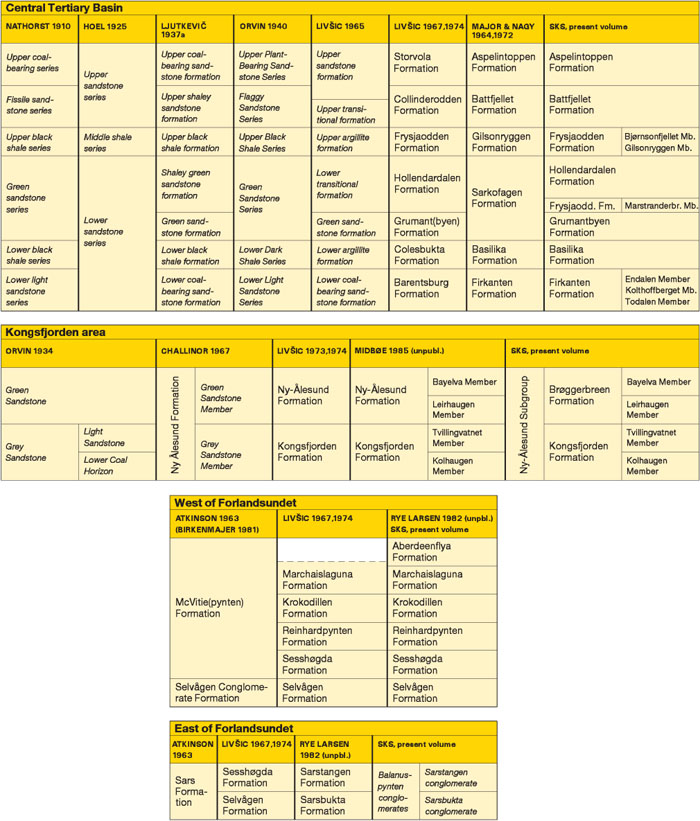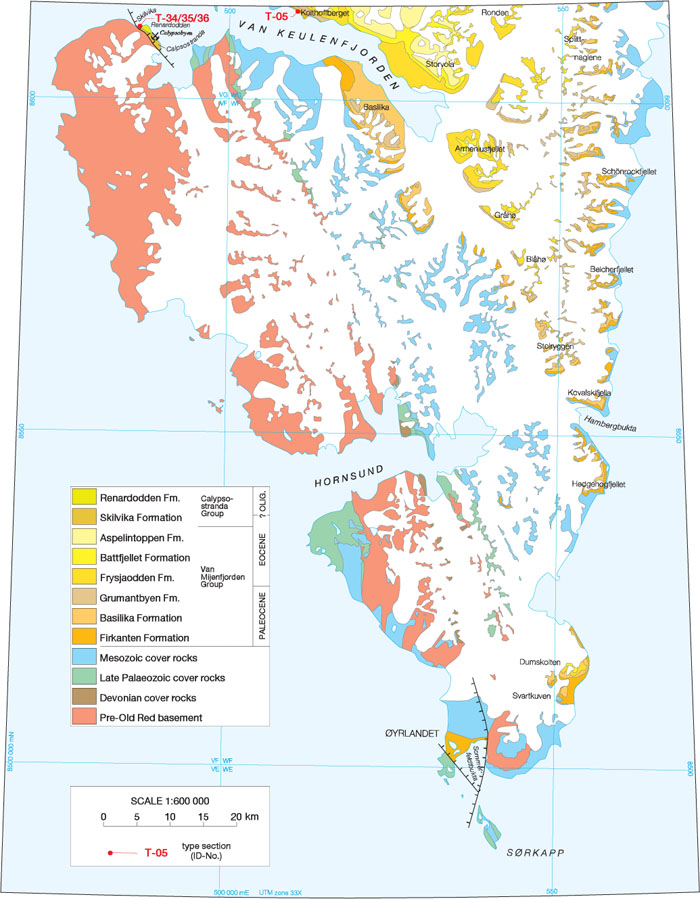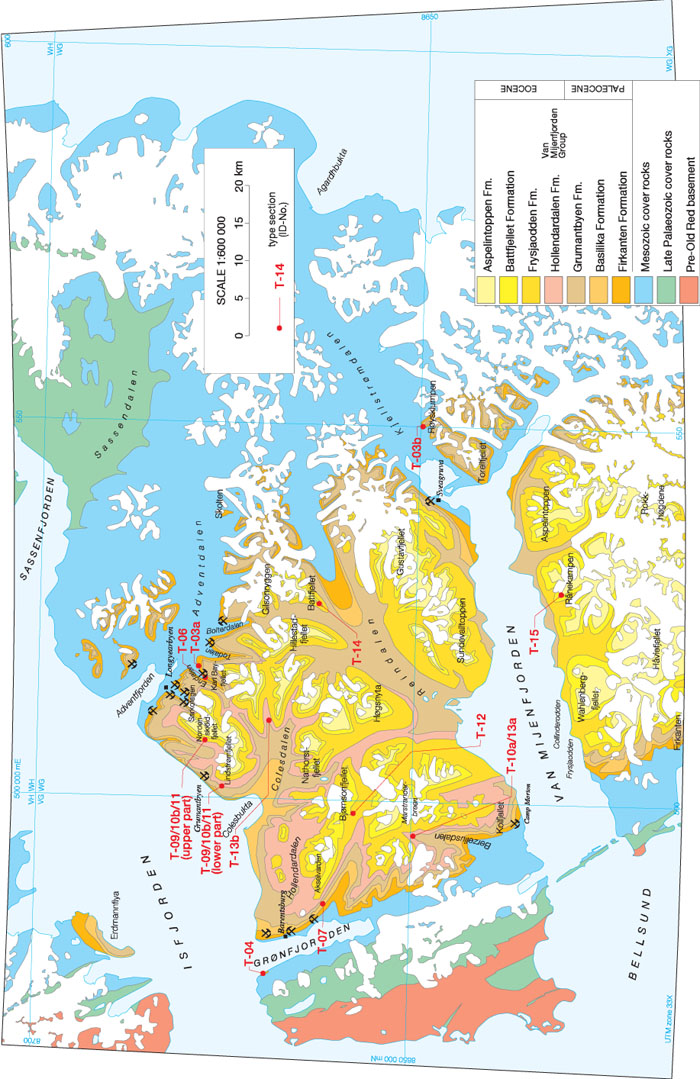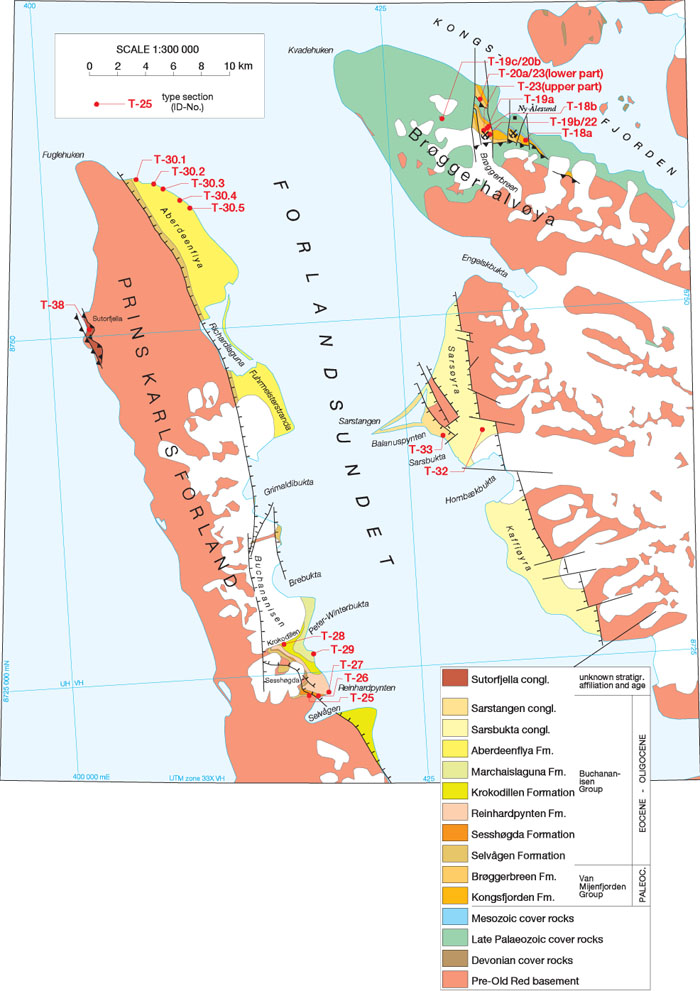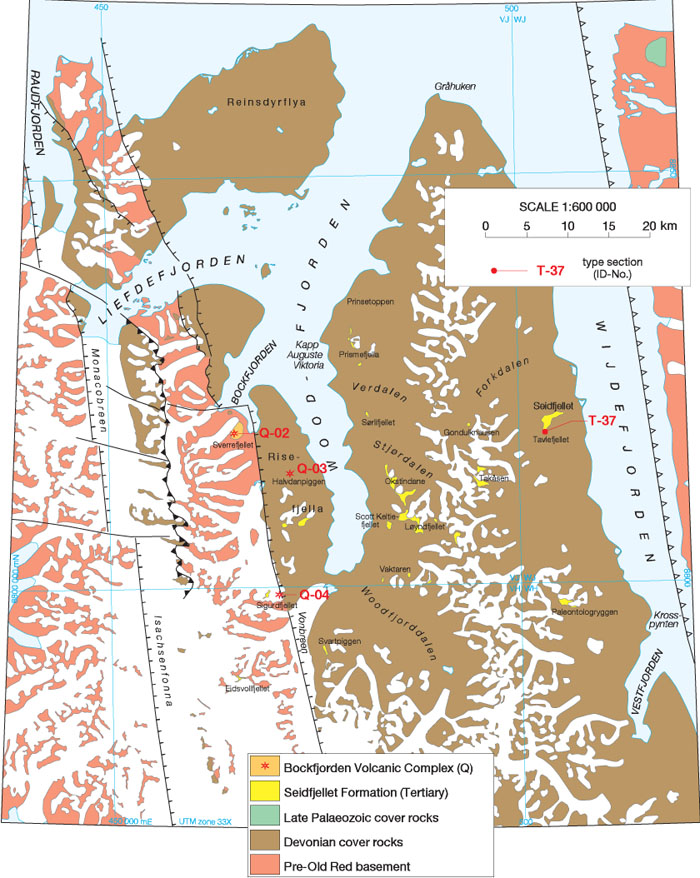4. CENOZOIC LITHOSTRATIGRAPHY
WINFRIED K. DALLMANN, PETER S. MIDBØE, ARVID NØTTVEDT & RON J. STEEL
4.1 General subdivision 4.2 Previous stratigraphic schemes 4.3 Regional descriptions and major revisions 4.3.1 Central Cenozoic Basin 4.3.2 Kongsfjorden area 4.3.3 Forlandsundet Graben 4.3.4 Renardodden area 4.3.5 Plateau basalts 4.4 Lexicon of lithostratigraphic units 4.5 Abandoned lithostratigraphic unit names 4.1 General subdivisionThe Cenozoic rocks of Svalbard are confined to several individual, probably isolated basins. The 18 formations and two additional, informal units are traditionally grouped according to their association with these basins (figs. 1-05, 4-01, 4-03). This grouping is maintained herein and extended to comprise all of the Cenozoic formations of Svalbard. The Central Cenozoic Basin is the largest and most prominent of the Cenozoic basins. Although the name refers to the present structural depression, it indicates also the remainder of the syn-orogenic foreland basin of a Cenozoic fold-thrust belt. Its sedimentary rock formations of Paleocene to Eocene age cover large areas of southern and central Spitsbergen (figs. 1-04, 4-04, 4-05). The seven formations constituting the Cenozoic clastic infill of this basin are grouped under the name Van Mijenfjorden Group (Harland 1969). The minor occurrence of Cenozoic rocks in the Cenozoic fold-thrust belt in the Kongsfjorden area (northwestern Spitsbergen) is now with great probability correlated with strata of the Central Cenozoic Basin. The rocks there are grouped as the Ny-Ålesund Subgroup (from "Ny-Ålesund Formation", Challinor 1967) and included in the Van Mijenfjorden Group.Back on top 4.2 Previous stratigraphic schemesThe stratigraphic schemes of the individual basins or stratigraphic groups have developed independently. For the Central Cenozoic Basin, the first six-fold subdivision by Nathorst (1910) and the first seven-fold subdivision by Ljutkevič (1937a) have remained valid through this century for all subsequent work in Norway and the Soviet Union, respectively (fig. 4-02). The presently proposed nomenclature is a synthesis of the Norwegian and Russian schemes, modified according to the present stratigraphic understanding.Back on top 4.3 Regional descriptions and major revisions4.3.1 Central Cenozoic BasinThe Central Cenozoic Basin (fig. 1-05) forms a NNW-SSE trending synclinorium in southern and central parts of the island of Spitsbergen, infilled with clastic rocks. The basin axis is asymmetrical and lies close to the western margin of the preserved part of the basin. The eastern basin limb dips gently (0-6°), the western limb more steeply (5-30°), towards the basin axis. The original sedimentary basin must have covered a considerably larger area. The Cenozoic sediments overlie strata of progressively younger Early Cretaceous age towards the southeast. The Cenozoic sediments are clastic, mostly sandstones and shales, coal-bearing in the lowermost and uppermost parts, representing delta-related shelf sedimentation of Paleocene to Eocene age. The upper part of the succession shows transport directions from the SSW and is thought to indicate the uplift of the Western Basement High. Six of the seven formations are traced throughout the area; all seven are collected within one group (Van Mijenfjorden Group, Harland 1969), overlying Early Cretaceous strata with a stratigraphic unconformity of 0.5-1°. The two almost equivalent stratigraphic subdivisions of the Van Mijenfjorden Group by Major & Nagy (1964, 1972) and Livšic (1967, 1974) (fig. 4-02) should be considered as contemporanously published. There was a significant delay in the publication process of the first mentioned work, which – in spite of its listed year of publication (1964) – actually was not printed before 1967. Furthermore, communication between geologists of the western countries and the Soviet Union was difficult at that time. Both stratigraphic subdivisions are well established in the western and eastern literature, respectively. The principle of priority through first publication is therefore disregarded. The present recommendation is based on establishment of names in the geological literature and on maps, completeness of namegiving sections and – where no other distinguishing criteria exist – better accessibility to the name-giving localities. The recommended use of formation names is thus based on the Norwegian scheme in the lower (Firkanten Formation, Basilika Formation) and upper levels (Battfjellet Formation, Aspelintoppen Formation) of the Central Cenozoic Basin, but on the Russian scheme in the middle part (Grumantbyen Formation, Hollendardalen Formation, Frysjaodden Formation). The formational subdivision reflects in general the alternaing sandstone and shale dominance in the succession. 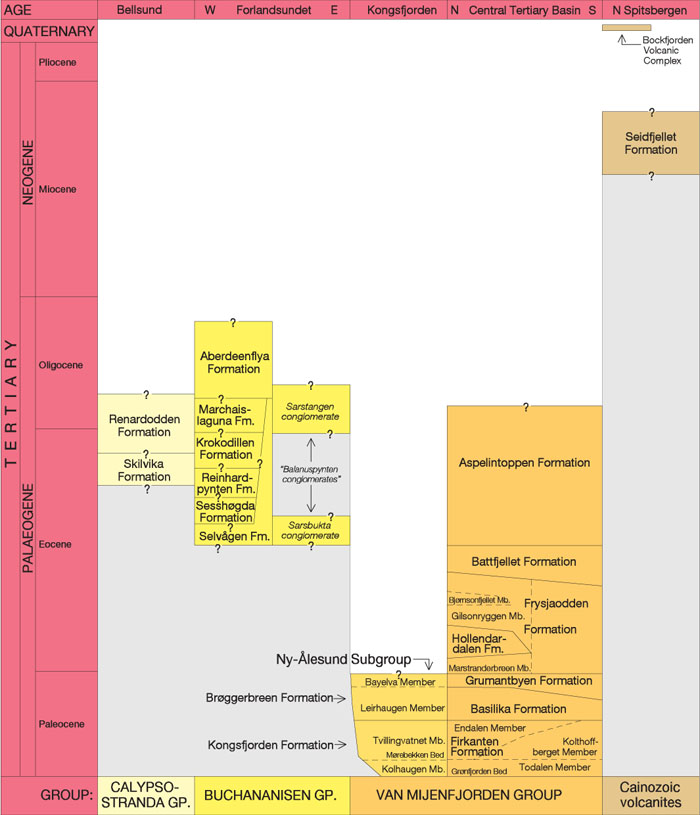
fig. 4-03: Proposed lithostratigraphic scheme for the Cenozoic of Svalbard. The diagram contains all names recommended by SKS at group, subgroup, formation, member and bed levels. Member and bed names in italics represent informal units. The ages and age boundaries of the units are indicated in accordance with existing data, but are admittedly schematic (see age discussions in section 4.4). Possible diachronous boundaries are drawn straight unless reliable data can document the diachronism. The age of the Buchananisen Group is not well-established, but is here applied from Livšic (1967, 1974) interpretations. The indicated major hiati are also drawn schematically and do not claim any precision concerning their age range. Minor hiati are omitted. The Øyrlandet area shows Cenozoic strata preserved within a southerly dipping halfgraben. Lithostratigraphic correlation with the Firkanten Formation in the southern termination of the Central Cenozoic Basin outcrops seems obvious (Dallmann et al. 1993). 4.3.2 Kongsfjorden area On the southwestern shore of Kongsfjorden, clastic Cenozoic strata occur in a tectonic block within the Cenozoic fold-andthrust belt (fig. 4-06). These unconformably overly Triassic and Permian rocks and are assigned to the Ny-Ålesund Subgroup. These strata are mostly considered to be correlatives of the lower part of the Van Mijenfjorden Group in the Central Cenozoic Basin (Midbøe 1985), although Livšic (1967, 1973, 1974, 1992) regards the Cenozoic of Kongsfjorden as the remainder of a separate basin of younger age. Because of the disagreements about the correlation, it is suggested use of separate formation names for these two areas, but include the strata in the Van Mijenfjorden Group. The names 'Kongsfjorden' and 'Brøggerbreen' for the two Cenozoic formations fit well, using relatively major geographical features for this important (though poorly exposed) coal-bearing unit, the fiord name describing the lower, and the glacier name describing the upper formation. 4.3.3 Forlandsundet Graben Cenozoic clastic strata are exposed within the Forlandsundet Graben on the western coast of north-central Spitsbergen and, particularly, on northeastern Prins Karls Forland (figs. 1-05, 4-06). The Forlandssundet Graben shows only part of the strata that were deposited within a larger sedimentary basin of possible partly pull-apart origin (Gabrielsen et al. 1992). These are clearly different from the Central Cenozoic Basin strata in facies and age (Eocene-Oligocene). They form an individual group which consists of seven formations of unknown continuity, laterally replacing each other in the surface sections. They unconformably overlie Precambrian basement. Most of the formations display incomplete stratigraphic sections. The stratigraphic nomenclature in this area was first established by Atkinson (1962, 1963) who defined the basal conglomeratic Selvågen Formation and the sandstone-shale dominated "McVitie Formation". Livšic (1967) subdivided the "McVitie Formation" into the Sesshøgda, Reinhardpynten, Krokodillen and Marchaislaguna formations, and Rye Larsen (1982, unpublished) added the uppermost sandstone-shale unit, the Aberdeenflya Formation (fig. 4-02). 4.3.4 Renardodden area A fault block southwest of Bellsund, at Renardodden, consists of clastic, coal-bearing Cenozoic strata unconformably overlying Precambrian basement, and representing the Calypsostranda Group (fig. 4-04). A structural connection with the depositional area of the Forlandsundet Graben is possible, though the strata of both areas cannot be correlated. Livšic (1967) defined the underlying Skilvika Formation and the overlying Renardodden Formation, both forming clastic fining-upward sequences, and mainly distinguished by the high number of coal seams in the lower formation. The exposed area is situated close to a long-lived fault zone that may have been active since Caledonian times (Dallmann 1989). 4.3.5 Plateau basalts Within the Devonian graben of northern Spitsbergen, Cenozoic plateau basalts (Seidfjellet Formation) unconformably overlie Devonian and Precambrian rocks (fig. 4-07). A correlation with the isolated basalt exposure at Manbreen in Ny Friesland, outside the graben, is tentative. Back on top |

